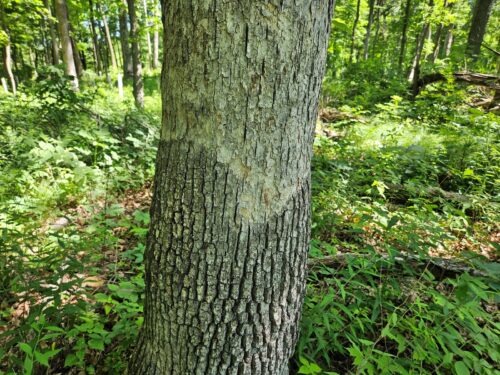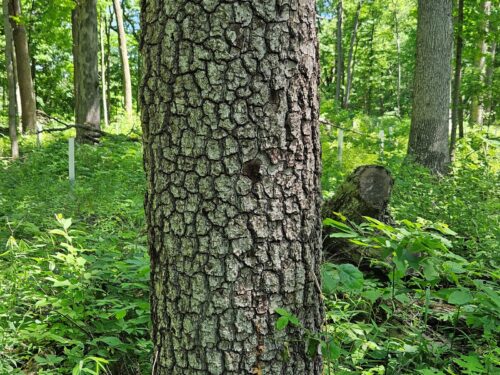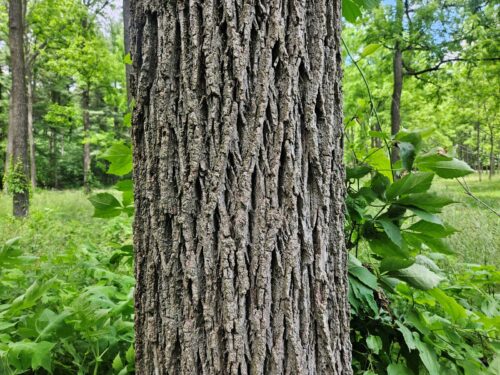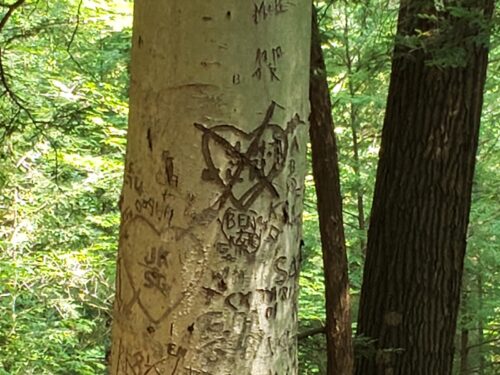 Purdue University - Extension - Forestry and Natural Resources
Purdue University - Extension - Forestry and Natural Resources
Got Nature? Blog
The long lifespan of many trees, which could be centuries or even millennia in the case of a few species, is a source of awe and inspiration for many. The bark of trees can often tell some stories about their life and history, if we know how to interpret what we see. Here are a few examples you may run across in Indiana.
Is this tree sick? That may be a natural question to ask when looking at the striking difference in the bark pattern on this white oak. In fact, it is an infection, but not a harmful one to the survival of the tree. This is called smooth patch and is caused by a fungus that infects the outer bark of oak and some other tree species. There are several species of fungus that may cause this appearance, but the most common is Aleurodiscus oaksii. The fungus gradually decomposes the outer layers of bark, producing the flattened and smooth surfaces which contrast with the rough bark that is uninfected. If you look closely during moist periods, you may see the small cup-shaped fruiting bodies of the fungus on the bark. It is not a threat to the health or integrity of the tree as only the outer bark is impacted.


This isn’t the same species of tree, is it? Yes, it is! Bark pattern differences in some species may reflect the growth rate or relative vigor of the tree. These photos show black walnut bark from two very different growing sites. The blocky, alligator-hide bark pattern is often an indication of slow growth and may result from a tree growing on a very difficult site, like the dry hilltop where this tree is located, or severe competition from surrounding trees. The strongly interlacing ridges of the bark in the second photo are from a black walnut growing in a plantation on a creek bench with deep, moist and fertile soils, resulting in more vigorous growth.


What happened here? The pattern in a horizontal line across these trees looks too perfect to be natural, but it was not produced by a human. This is the feeding activity of the yellow-bellied sapsucker, a species of woodpecker that migrates through Indiana. The sapsucker, true to its name, uses its sharp bill to create holes through the bark that ooze sap. The sapsucker feeds on the sap and may also feed on insects drawn to the sap. They tend to create straight lines of holes that leave this diagnostic pattern behind, even long after the birds have ceased their activity. This activity is usually not fatal to the tree, but does cause some damage to the wood beneath the bark, so trees that have been used by sapsuckers may have discolored spots or other blemishes in the wood revealed when processed for wood products. To see images and learn more about sapsuckers visit American Bird Conservatory Website.

Humans also may leave a history of our presence on trees. This American beech tree in a recreation area has recorded the comings and goings of visitors, with some apparent editing as well! I do not endorse this activity as it can be harmful to the tree by introducing avenues for decay and disease, and is generally prohibited on public property. Instead, enjoy reading the nature stories found in bark.

Resources:
Hardwoods of the Central Midwest, Purdue Arboretum Explorer
Forest Improvement Handbook, The Education Store, Purdue Extension’s resource center
ID That Tree, Purdue Extension-Forestry & Natural Resources (FNR) YouTube playlist
Native Trees of the Midwest, The Education Store
Woodland Management Moment , Purdue Extension-FNR YouTube playlist
Tree Installation: Process and Practices, The Education Store, Purdue Extension’s resource center
Planting Your Tree Part 1: Choosing Your Tree, video, The Education Store
Tree Risk Management – The Education Store
Find an Arborist website, Trees are Good, International Society of Arboriculture (ISA)
Subscribe Purdue Extension-Forestry and Natural Resources YouTube Channel
Lenny Farlee, Extension Forester
Hardwood Tree Improvement and Regeneration Center
Purdue Department of Forestry & Natural Resources

Recent Posts
- 2024 Turkey Brood Count Wants your Observations – MyDNR
Posted: June 28, 2024 in Alert, Community Development, Wildlife - Case Study: Maple Tree Pests – Purdue Landscape Report
Posted: June 26, 2024 in Disease, Forests and Street Trees, Plants, Spiders, Urban Forestry, Wildlife, Woodlands - Woodland Management Moment: Oak Regeneration – Protecting Seedlings
Posted: June 24, 2024 in Forestry, Urban Forestry, Wildlife, Woodland Management Moment, Woodlands - Stories in the Bark – Patterns and Growth
Posted: June 22, 2024 in Forestry, Forests and Street Trees, Wildlife, Woodlands - Indiana’s Surprise Onion Plants Emerge
Posted: June 20, 2024 in Forestry, Forests and Street Trees, Plants, Urban Forestry, Wildlife, Woodlands - Celebrate Pollinator Week With Flowers of June Tour
Posted: in Forestry, Gardening, Wildlife - Leaf Curl and Blister Due to Wet Weather – Purdue Landscape Report
Posted: June 7, 2024 in Forestry, Forests and Street Trees, Urban Forestry, Wildlife - Learn How to Support Oak-Hickory Ecosystems
Posted: June 4, 2024 in Forestry, How To, Urban Forestry, Wildlife - Turtle Traffic: Save Turtles From Roads – My DNR
Posted: June 3, 2024 in How To, Wildlife - Spongy Moth in Spring Time – Purdue Landscape Report
Posted: in Alert, Forestry, Forests and Street Trees, How To, Invasive Insects, Urban Forestry
Archives
Categories
- Alert
- Aquaculture/Fish
- Aquatic/Aquaculture Resources
- Ask the Expert
- Christmas Trees
- Community Development
- Disease
- Drought
- Forestry
- Forests and Street Trees
- Gardening
- Got Nature for Kids
- Great Lakes
- How To
- Invasive Animal Species
- Invasive Insects
- Invasive Plant Species
- Land Use
- Natural Resource Planning
- Nature of Teaching
- Plants
- Podcasts
- Ponds
- Publication
- Safety
- Spiders
- Timber Marketing
- Uncategorized
- Urban Forestry
- Webinar
- Wildlife
- Wood Products/Manufacturing
- Woodland Management Moment
- Woodlands